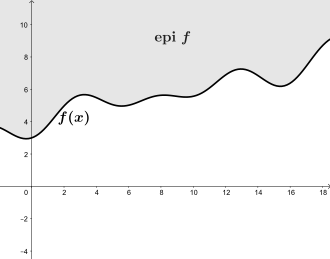
Back Epigraph (Mathematik) German Epigrafo Spanish اپی گراف Persian Épigraphe (mathématiques) French אפיגרף (מתמטיקה) HE Epigrafico (matematica) Italian エピグラフ (数学) Japanese Epigrafo Portuguese Надграфик Russian Epigraph (mathematics) SIMPLE


In mathematics, the epigraph or supergraph[1] of a function valued in the extended real numbers is the set consisting of all points in the Cartesian product lying on or above the function's graph.[2] Similarly, the strict epigraph is the set of points in lying strictly above its graph.
Importantly, unlike the graph of the epigraph always consists entirely of points in (this is true of the graph only when is real-valued). If the function takes as a value then will not be a subset of its epigraph For example, if then the point will belong to but not to These two sets are nevertheless closely related because the graph can always be reconstructed from the epigraph, and vice versa.
The study of continuous real-valued functions in real analysis has traditionally been closely associated with the study of their graphs, which are sets that provide geometric information (and intuition) about these functions.[2] Epigraphs serve this same purpose in the fields of convex analysis and variational analysis, in which the primary focus is on convex functions valued in instead of continuous functions valued in a vector space (such as or ).[2] This is because in general, for such functions, geometric intuition is more readily obtained from a function's epigraph than from its graph.[2] Similarly to how graphs are used in real analysis, the epigraph can often be used to give geometrical interpretations of a convex function's properties, to help formulate or prove hypotheses, or to aid in constructing counterexamples.
© MMXXIII Rich X Search. We shall prevail. All rights reserved. Rich X Search
![{\displaystyle f:X\to [-\infty ,\infty ]}](https://wikimedia.org/api/rest_v1/media/math/render/svg/cb5b80b60f448c0542dc59fd71f22b8ce01e8bc7)
![{\displaystyle [-\infty ,\infty ]=\mathbb {R} \cup \{\pm \infty \}}](https://wikimedia.org/api/rest_v1/media/math/render/svg/f784980f597dae36b4d32c2a89de0a449e99aca8)










![{\displaystyle [-\infty ,\infty ]}](https://wikimedia.org/api/rest_v1/media/math/render/svg/e13233867b861889693a36843d98e51d90d38f9f)

